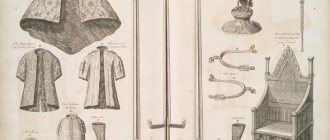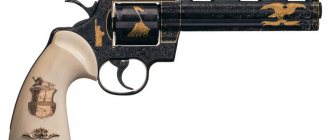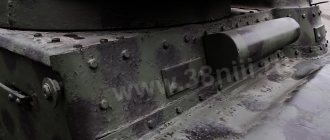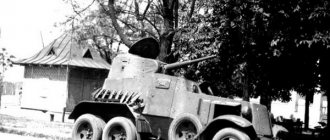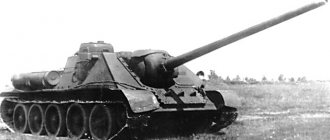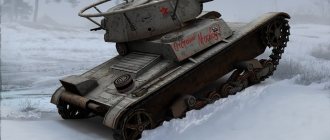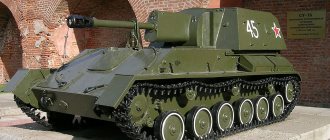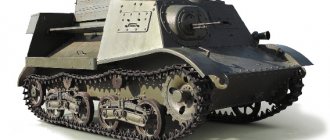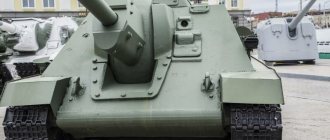Firearms
- products structurally intended for mechanical destruction of a living or other target at a distance with a projectile receiving directed movement due to the combustion energy of the propellant charge,
According to the Federal Law “On Weapons”, a firearm is a weapon designed to mechanically hit a target at a distance with thrown equipment that receives directional movement due to the energy of a powder or other charge; firearms of limited destruction - short-barreled weapons and barrelless weapons intended for mechanical destruction of a living target at a distance by throwing equipment of a traumatic cartridge, receiving directed movement due to the energy of a powder or other charge, and not intended to cause death to a person[1].
A firearm is a weapon in which a projectile (bullet, shot, buckshot) receives forward motion due to the action of powder gases formed during the combustion of an explosive. On this basis, firearms differ from other types of weapons (pneumatic, throwing). Flare guns, mortar guns, and gas pistols can only be classified as firearms if they are specifically designed to inflict serious bodily harm.
Formally, multiple launch rocket systems are also classified as firearms. Although in fact MLRS are a type of missile weapon.
Invention of gunpowder
Gunpowder was known in China already in the 11th century. Most likely, information about him came to Europe through Muslim Spain. The earliest evidence of firearms, contained in the chronicles of the Italian city of Florence, dates back to the 14th century, and the first drawing depicting such a weapon is in a 14th-century English royal manuscript. The first samples already have those external signs that will be traced throughout the development of firearms.
Roger Bacon, naturalist, philosopher and Franciscan monk. In his 13th century manuscript. contains an anagram that encrypts the recipe for gunpowder. Scholars such as Bacon received much information from the East through Muslim Spain
The early history of gunpowder is both confusing and interesting. India, China, the Arab world and Western Europe are arguing about where exactly gunpowder was invented. In any case, it has long been known that gunpowder consists of saltpeter, charcoal and sulfur. A careful study of the sources shows that although Chinese alchemists already in the 11th century. were familiar with gunpowder, they were not looking for a propellant, but an incendiary mixture. Although alchemists in many countries and cultures may well have known about gunpowder, they probably had no idea in what ratio the ingredients should be mixed to create an explosive.
Milemet gun
Many early references to firearms are associated with military campaigns.
In the XIV-XV centuries. The longest conflict in Europe was the Hundred Years' War, which lasted until 1453. The army of the English king Edward III during the campaign in Scotland could well have been armed with cannons. The scholar Walter de Milemete included in his manuscript dated 1326 a drawing of a jug-shaped weapon mounted on a trestle. Guns of this kind gradually became more widespread. A large metal arrow sticks out of the jug. Probably, the arrow shaft was wrapped with some kind of wad in order to make maximum use of the propellant force of gunpowder. The jug itself could be cast from cast iron or bronze. To ignite the gunpowder, a hot metal rod or something similar was applied to the seed hole. Over time, firearms began to be used more and more often.
The earliest depiction of a firearm is from Walter de Milemete's manuscript "Oe Notabilitatibus, Sapientis et Prudentia", dated 1326. More advanced tools were soon invented
Current situation
For many years, the Tula Arms Plant remained the flagship of arms production. It was here that the first Russian flint pistols, rifles and revolvers appeared. Since 1933, this company has produced the famous TT pistol - the Tula Tokarev. Currently, here in Tula, the Rostec state corporation continues to create military, hunting and sporting weapons. And the enterprise itself has long become a global brand. It is impossible not to mention another plant where small arms are created - Izhmash. It was here that the production of the Kalashnikov assault rifle began in the 40s. Now, the Kalashnikov assault rifle created by Rostec is the most famous small arms in the world.
Mikhail Kalashnikov. (wikipedia.org)
Letters are written about him, he is put on the coats of arms and flags of other states (Mozambique). The machine has proven its effectiveness and superiority over its competitors many times. According to statistics, every fifth assault rifle in the world is an AKM. Moreover, weapons continue to be improved. Thus, at the Army 2015 exhibition, Rostec presented fundamentally new Kalashnikov models.
First evidence
The oldest convincing evidence for gunpowder comes from 13th-century European manuscripts. Gunpowder is mentioned in Marcus the Greek's Liber Ignium, which appeared around 1300, and in De Mirabilium Mundi, written by Albertus Magnus, who died in Cologne in 1280. The most famous mention of gunpowder is found in a manuscript by Roger Bacon, dating from about 1260. In his “Epistolae de secretis operibus artis et naturae et de NULLitate magial” there is a Latin anagram that stands for: “Seven parts of saltpeter, five parts of freshly obtained sulfur color and five parts of charcoal." This is the recipe for gunpowder. Gunpowder is also used in the manuscripts "Opus Majus" and "Opus Tertium", dating respectively from 1267 and approximately 1266-1268, which describe the making of fireworks. In particular, it is proposed to wrap gunpowder in a parchment wrapper the size of a little finger, vaguely reminiscent of a later paper cartridge.
If gunpowder was invented in China, it probably came to Western Europe in the first half of the 13th century. through the alchemists of Moorish Spain. It appears that the role of the Arabs in the early history of gunpowder and firearms has not yet been fully appreciated. An Arabic treatise kept in St. Petersburg describes arrows or bullets that are shot from a pipe using gunpowder. However, the dating of this manuscript is controversial, so the claim that firearms were an Arab invention is currently unprovable.
Webley revolver
0
Source:
The Webley Revolver is a break-action revolver chambered in 455 Webley. Began to be produced in the 1870s by the English company Webley & Son Company (currently called Webley & Scott Co). In 1887, the Webley-Green system revolver was adopted by the British Army and was in service with the army until 1963. The design with a turning frame provides a fairly high reloading speed, comparable to revolvers with a cylinder that flips to the side. Webley revolvers have a locking case, the frame of which consists of two parts connected by a hinge. To reload, the barrel was tilted down, the body was “broken,” and the extractor was automatically turned on, ejecting all 6 cartridges from the drum. The drum chambers were then filled by hand. In The Godfather Part II, young Vito Corleone kills Don Falucci with such a revolver, then he smashes it and throws the remains down the chimneys. This revolver has been Indiana Jones' weapon of choice since Indiana Jones and the Last Crusade. Leonardo DiCaprio's character in The Great Gatsby was also shot with this revolver.
The first guns
According to legend, firearms were invented by a German monk named Berthold Schwartz from the city of Freiburg in southwestern Germany. When he was making gunpowder and grinding the ingredients with a pestle in a mortar, the mixture exploded and threw the pestle out of the mortar with great force, which gave the monk the idea of a gun. Berthold Schwartz is a legendary figure, but this story may well contain a grain of truth, since it was written down in the 15th century.
The legendary German monk Berthold Schwartz. According to legend, he conducted alchemical experiments with the goal of making mercury solid and at the same time around 1320 he invented gunpowder
Information about primitive guns is available in both Chinese and Arabic sources. In a Chinese source of the 12th century. a bamboo tube filled with gunpowder and used to shoot arrows is described. Firearms are mentioned in a 17th-century military treatise based on much older books. The weapon described in this treatise is a copper tube, loaded with an arrow and equipped with a prototype of a butt, a short stick. A very similar primitive gun is depicted in an Arabic manuscript from the 14th century. Many early guns were designed to fire arrows rather than bullets.
In 1326, the Florentine council passed a resolution ordering two citizens to make “iron bullets or arrows and a metal cannon.” Subsequent documents, dated the same year and also discovered in Florence, mention "cannon, iron balls and gunpowder." The earliest drawing of a firearm, the so-called Milemete cannon, that can be accurately dated dates back to 1326.
With its shape, this gun is very reminiscent of a vase or bottle. This form was not at all a tribute to the artistic taste of its time. It was determined by the need to strengthen the rear part of the gun, in which the powder charge exploded, and was the result of learning harsh lessons when guns simply exploded at a weak point.
First innovations
The Milemete gun reflects an early stage in the development of firearms, when arrows were considered the most effective projectiles. However, the shape of the arrows was not very suitable for maximum use of the explosive power of gunpowder, and by the end of the 14th century. they were almost everywhere replaced by stone cores.
Cinema props
0
Source:
In movies, there are often interesting weapons made specifically for a particular film. As was the case with the film “Aliens,” which has already become a classic in its genre, for example. The M41A Pulse Rifle carried by Marines is a hybrid of the Thompson M1 submachine gun found in most gangster movies and the 12-gauge SPAS-12 Franchi shotgun. It is noteworthy that the concept of combining a rifled and smooth barrel into a single weapon system is reflected in real life (this has been practiced in hunting weapons for a long time). The real-life Crossfire MK-1 combines a .223 Rem rifle with a 12-gauge shotgun. Here the smooth barrel is located on top, and the rifled one on the bottom; the tubular magazine for the smoothbore is located in the upper part of the butt. The weapon is also equipped with a collimator sight. You may remember other examples of weapons made specifically for filming.
The first handgun
It soon became clear that the shape of a jug for a cannon barrel was not the most successful, and such traditional projectiles as arrows did not fit the new invention in the best way. Over time, gun barrels began to be made into shapes more familiar to us. The next step was to find the most effective ignition method. It was also necessary to find a way to soften the recoil, that is, the sharp jerk of the gun back when fired. The effectiveness of firearms increased and handguns emerged.
Loshult Handbrake
The oldest hand cannon known to us, the Loshult hand cannon, was found during excavations in Sweden in 1861. It is cast from bronze, has a characteristic jug shape, and the seed hole is countersunk to form a simple powder shelf. The handle dates back to the first half of the 14th century. Another handbrake, found in Sweden at the bottom of the sea near Morko, also dates back to the 14th century. On the multifaceted bronze barrel, behind a square powder flange with a seed hole, a bronze figure is placed, and under the reinforced breech there is a protruding hook. Such a hook was intended to reduce recoil when fired; The old Russian name for such a weapon, “gakovnitsa,” comes from the word “hook,” that is, hook. Religious texts are engraved on the barrel. The length of this cannon is very short, so it certainly served as a hand weapon.
An ancient weapon found in Sweden near Loshult and dating back to approximately 1350. The Loshult weapon looks like a miniature cannon. Apparently, it was fired in the same way as from the weapon depicted in the Milemet manuscript, that is, from a primitive carriage
Another ancient handbrake was found in the ruins of Tannenberg Castle in Germany, destroyed in 1399. It is also bronze with a faceted barrel, and its breech is also noticeably strengthened. The bore in front of the powder chamber in which the projectile was placed was made narrow, probably to increase the efficiency of the powder gases. The Tannenberg handbrake dates back to approximately 1350.
Device
Both the weapon from the Milemet manuscript and the weapon from Loshult look more like cannons than handguns; both have bulbous extensions at the breech. The straight-barreled weapon found near Morko now looks more like a hand-held weapon. Probably no machine was required when firing it. This hand grip, like the Tannenberg Castle hand grip, is a straight metal pipe attached to a simple wooden stock of some design. It is possible that such weapons fired metal arrows, although the Tannenberg handgun, when found, was loaded with a lead bullet. Many examples of antique hand cranks have been found in Spain, Switzerland, Sweden and England.
This handbrake was found near Morko at the bottom of the Baltic Sea. The hexagonal barrel is typical for ancient weapons. This find marks an important stage in the development of handguns - it does not have the bulbous extension in the breech of the barrel that is typical of small guns. Instead, the weapon has a “modern” straight barrel
Semi-automatic Borchardt pistol
0
Source:
The introduction of the semi-automatic Borchardt pistol in the late 1890s received rave reviews in the press. Borchardt K93 (Borchardt C93) became the world's first successful self-loading pistol of the system of the German designer Hugo Borchardt, chief engineer of the German arms industry. The first working model of the pistol appeared in early 1893. In the same year, the design was patented in England, and then in nine more countries, including Germany, France, Italy and the USA. In 1895, in Russia, at the request of process engineers Kaupe and Chekalov, Borchardt was issued a privilege (patent) for a period of 10 years for a “Repeat pistol with a rebound action.” This weapon has become universal for hunters and travelers. Here is how, for example, the Russian cavalry officer, captain Baron Kaulbars, assessed the Borchardt and Mauser pistols: “The Borchardt pistol has, in contrast to other systems, the convenience that: 1. It can be loaded in two seconds in the dark. 2. With a full magazine, it is still not loaded and the hammer is not cocked, while the Mauser is loaded and the hammer is cocked. 3. “Borchardt” is discharged in one second, but “Mauser” can only be discharged by shots or by opening the bolt and pouring cartridges into the hand one by one, using the bolt of the clip, which, however, is no longer needed for new loading.”
How the first guns were fired
Shooting from handguns in the 15th century. Illustration from the book “Rudimentum Noviciorum”, published in Lübeck. Hand grips are attached to long shafts and equipped with seed holes
The metal trunks of the Tannenberg handbrake and the Morco handbrake are about 300 mm long. The bore diameter is about 17 mm. There was a powder chamber in the handgun, to which a narrow seed hole led, drilled at right angles to the barrel. Gunpowder and a shell were placed in the barrel. To fire a shot, a hot wire was probably inserted into the seed hole. Another method was to use a smoldering wick. The wick was usually made from twine soaked in a solution of potassium nitrate and then dried. When lit, such a wick burned slowly at a predictable rate.
It is believed that a bullet fired from a handgun could pierce the steel armor common at that time at a moderate distance. In addition, the roar of the shot and the bright flash should have had a strong psychological effect on the enemy. Do not underestimate the effectiveness of this relatively primitive weapon.
Antique hand cannon from Wedelspang Castle in Copenhagen. This long, thin hook, dating from around 1400, was probably more effective when used as a club
Further more
And yet, European gunsmiths, and most importantly those who placed orders for them, had something to work on. And the arquebus, and the musket, and the pistol were not as effective as we would like. In order to fire an arquebus, you had to light the fuse and wait for it to burn out. The musket, which hit a target at a distance of up to 250 meters, was a kind of version of a hand cannon.
The weight of such guns sometimes reached 20-25 kilograms. For aiming, a special stand was used, which was dug into the ground. Locks on pistols jammed more often than on shotguns. And, most importantly, of all this, only one shot could be fired. Then recharging began, which took several minutes. And during such reloading the shooter remained unarmed. But the appearance of multi-charged guns was not long in coming. Already in the 17th-18th centuries, the first machine guns began to appear. These were, of course, not the same machine guns that were actively used, for example, in the Civil War in Russia. In France, for example, gunsmiths created a structure consisting of a wheelbarrow and forty gun barrels tied together. Each of them fired one shot, but together it turned out to be forty. In 1718, British lawyer James Puckle introduced his gun to the world. This invention is notable only for the fact that it featured a drum for the first time.
It could fire up to 8 rounds per minute, but was too bulky and inconvenient for effective use in combat conditions. Then there was the mitrailleuse, a French artillery piece that fired bursts. It was probably the mitrailleuse that inspired the American doctor Richard Jordan Gatling to create one of the deadliest weapons of the 19th century.
Patent description of the Gatling gun. (wikipedia.org)
The Gatling gun was patented in 1862 and later found use in the American Civil War. Over time, the doctor improved his invention so that Gatling could fire up to 400 shots per minute.
Pistols have also undergone evolution. With the advent of a drum designed for 6-7 bullets, they became noticeably more effective than before. The first revolver was patented in 1818 by the American officer Artemas Wheeler. And the greatest success in their production was achieved by Samuel Colt, the creator of the capsule revolver, which was named after him.
Samuel Colt. (wikipedia.org)
Where did the fusee come from?
It cannot be said that before Peter the Great in Russia they did not know what a fusee was. Flintlock guns began to spread widely in Europe at the beginning of the 17th century. Quite soon they reached the Russian kingdom, most likely with the troops of the Polish-Lithuanian Commonwealth, and therefore, along with a new type of weapon, its Polish name was borrowed - fuzja, which goes back to the French word “fusil”, that is, “gun”. Lighter and more convenient than a musket, this weapon was much better suited for the large-scale rearmament of the army, which was started by Peter I. So the first Russian fuses appeared even before the start of the Northern War. In 1695, a batch of 1,000 barrels of this type of weapon was produced in Tula, albeit with imported Swedish locks: the development of Russia’s own percussion flintlocks had not been completed by that time.
But such a scale of production could not satisfy the Russian army, which was preparing to fight, and soon entered into its first major war of the 18th century. The army needed tens and hundreds of thousands of fuses. Therefore, at first, almost half of the standard army weapons that came to the Armory Chamber were imported: merchants brought from abroad both ready-made fuses, as well as individual barrels for them and even individual locks. All this did not help in any way to solve the main task: to provide the army with uniform weapons, the presence of which greatly facilitated supply. The discrepancy in weapon systems and even calibers led to the fact that many soldiers had to do the casting of bullets for their guns on their own. For weapons of one type and caliber, this work could be concentrated in regimental workshops, and this would provide the troops with a much larger supply of ammunition.
Fuseliers of infantry regiments, from 1700 to 1720. Drawing from the monograph by Alexander Viskovatov “Historical description of clothing and weapons of the Russian troops, with drawings, compiled by the highest order,” 1841-1862.
Source: memorandum.ru
Smith & Wesson Model 64
0
Source:
The legendary Model 64 of the iconic Smith & Wesson revolver is a redesign of the Model 10, the so-called “military and police” (army and police). This model was produced without interruption for almost a century. From time to time its design was improved, but the basic design did not undergo any fundamental changes, and the modern Model 10 is not much different in appearance from the original 1899 revolvers. The main noticeable difference of later models is the beveled front sight and wider trigger shank. The first Military & Policy model closely resembled a .32 caliber revolver, except that it had a cylinder latch placed under the shooter's thumb. In 1900, the US Army and Navy each ordered a thousand of these revolvers, stipulating that they be chambered for the .38 Colt Long cartridge and have a 6.5-inch barrel with left-hand rifling. The third modification, also known as the 1905 model, underwent minor modifications four times, and the last changes were made to its design in 1915. Since then, the revolver has not been redesigned until 1942, when its production was discontinued. This iconic weapon, in particular, was in the hands of Bond, James Bond. In the novel Dr. No, a gunsmith recommends a Smith & Wesson Sentinel Aircraft in .38 caliber (9.65 mm). At the end of the novel (this was not included in the film), Bond sends an ironic coded message: “Please inform the gunsmith of the ineffectiveness of Smith & Wesson against flamethrowers.” Apparently, apologizing for this joke, in 1973, already in the cinema (Live and Let Die), Bond works well with a large-caliber Smith & Wesson.
Ruger P89 pistol
0
Source:
Ruger P is a series of pistols developed and manufactured by the American company Sturm, Ruger & Company, Inc. The first pistol in the series was the P85, which was developed in 1985 and entered the market in 1987. Almost all internal parts, including the barrel, were made of stainless steel. All pistols of the P85-P94 series have almost the same design. In the early 2000s, US legislation relaxed the concealed carrying of firearms for the self-defense of civilians. This created a huge demand for weapons, and they had to be small, thin, light, have an increased magazine capacity, night or high-contrast sights, an ergonomic safety and an ambidextrous magazine catch. Ruger designed its pistols with the goal of capturing the rapidly growing and profitable segment of the concealed carry gun market. And their products met the specified requirements at midnight.
Tommy gun
0
Source:
The Thompson submachine gun (Tommy gun) is an American submachine gun developed by Auto-Ordnance in 1920 and used extensively during World War II. It was a small-sized light machine gun suitable for use by one person, designed for close-range combat and assault on trenches and other fortifications. Thompson called his development submachine-gun - that is, literally, “submachine gun,” “a lighter type of machine gun.” This term has established itself in American English and is used to this day to designate a hand-held automatic weapon chambered for a pistol cartridge, which in Russian terminology is called a submachine gun. The Thompson gained its greatest fame during the Prohibition era - as a weapon of American gangsters. Even the state control over the sale of weapons, introduced in 1928, could not prevent the Thompsons from falling into their hands. "Tommy guns" were used during the St. Valentine's Day massacre, which thundered throughout America, which occurred on February 14, 1929 in Chicago. The Thompson submachine gun became the basis for the creation of the futuristic M-41A weapon from the movie “Aliens” (we already mentioned this). Translator's note: they say that Tony Montana in the famous film "Scarface" fired from an M16A1 with an M203 grenade launcher, and not from a Tommy gun.

